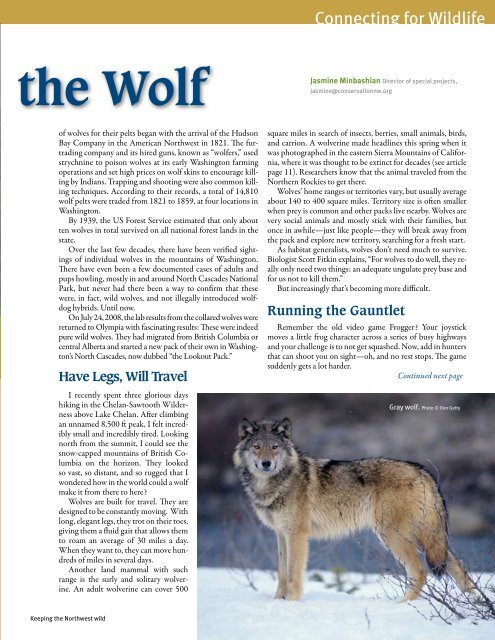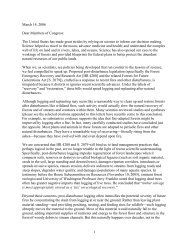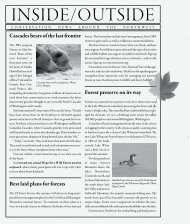the Wolf
September 2008 - Return of the Wolf - Conservation Northwest
September 2008 - Return of the Wolf - Conservation Northwest
- No tags were found...
Create successful ePaper yourself
Turn your PDF publications into a flip-book with our unique Google optimized e-Paper software.
Connecting for Wildlife<br />
<strong>the</strong> <strong>Wolf</strong><br />
Jasmine Minbashian Director of special projects,<br />
jasmine@conservationnw.org<br />
of wolves for <strong>the</strong>ir pelts began with <strong>the</strong> arrival of <strong>the</strong> Hudson<br />
Bay Company in <strong>the</strong> American Northwest in 1821. The furtrading<br />
company and its hired guns, known as “wolfers,” used<br />
strychnine to poison wolves at its early Washington farming<br />
operations and set high prices on wolf skins to encourage killing<br />
by Indians. Trapping and shooting were also common killing<br />
techniques. According to <strong>the</strong>ir records, a total of 14,810<br />
wolf pelts were traded from 1821 to 1859, at four locations in<br />
Washington.<br />
By 1939, <strong>the</strong> US Forest Service estimated that only about<br />
ten wolves in total survived on all national forest lands in <strong>the</strong><br />
state.<br />
Over <strong>the</strong> last few decades, <strong>the</strong>re have been verified sightings<br />
of individual wolves in <strong>the</strong> mountains of Washington.<br />
There have even been a few documented cases of adults and<br />
pups howling, mostly in and around North Cascades National<br />
Park, but never had <strong>the</strong>re been a way to confirm that <strong>the</strong>se<br />
were, in fact, wild wolves, and not illegally introduced wolfdog<br />
hybrids. Until now.<br />
On July 24, 2008, <strong>the</strong> lab results from <strong>the</strong> collared wolves were<br />
returned to Olympia with fascinating results: These were indeed<br />
pure wild wolves. They had migrated from British Columbia or<br />
central Alberta and started a new pack of <strong>the</strong>ir own in Washington’s<br />
North Cascades, now dubbed “<strong>the</strong> Lookout Pack.”<br />
Have Legs, Will Travel<br />
I recently spent three glorious days<br />
hiking in <strong>the</strong> Chelan-Sawtooth Wilderness<br />
above Lake Chelan. After climbing<br />
an unnamed 8,500 ft peak, I felt incredibly<br />
small and incredibly tired. Looking<br />
north from <strong>the</strong> summit, I could see <strong>the</strong><br />
snow-capped mountains of British Columbia<br />
on <strong>the</strong> horizon. They looked<br />
so vast, so distant, and so rugged that I<br />
wondered how in <strong>the</strong> world could a wolf<br />
make it from <strong>the</strong>re to here?<br />
Wolves are built for travel. They are<br />
designed to be constantly moving. With<br />
long, elegant legs, <strong>the</strong>y trot on <strong>the</strong>ir toes,<br />
giving <strong>the</strong>m a fluid gait that allows <strong>the</strong>m<br />
to roam an average of 30 miles a day.<br />
When <strong>the</strong>y want to, <strong>the</strong>y can move hundreds<br />
of miles in several days.<br />
Ano<strong>the</strong>r land mammal with such<br />
range is <strong>the</strong> surly and solitary wolverine.<br />
An adult wolverine can cover 500<br />
square miles in search of insects, berries, small animals, birds,<br />
and carrion. A wolverine made headlines this spring when it<br />
was photographed in <strong>the</strong> eastern Sierra Mountains of California,<br />
where it was thought to be extinct for decades (see article<br />
page 11). Researchers know that <strong>the</strong> animal traveled from <strong>the</strong><br />
Nor<strong>the</strong>rn Rockies to get <strong>the</strong>re.<br />
Wolves’ home ranges or territories vary, but usually average<br />
about 140 to 400 square miles. Territory size is often smaller<br />
when prey is common and o<strong>the</strong>r packs live nearby. Wolves are<br />
very social animals and mostly stick with <strong>the</strong>ir families, but<br />
once in awhile—just like people—<strong>the</strong>y will break away from<br />
<strong>the</strong> pack and explore new territory, searching for a fresh start.<br />
As habitat generalists, wolves don’t need much to survive.<br />
Biologist Scott Fitkin explains, “For wolves to do well, <strong>the</strong>y really<br />
only need two things: an adequate ungulate prey base and<br />
for us not to kill <strong>the</strong>m.”<br />
But increasingly that’s becoming more difficult.<br />
Running <strong>the</strong> Gauntlet<br />
Remember <strong>the</strong> old video game Frogger? Your joystick<br />
moves a little frog character across a series of busy highways<br />
and your challenge is to not get squashed. Now, add in hunters<br />
that can shoot you on sight—oh, and no rest stops. The game<br />
suddenly gets a lot harder.<br />
Continued next page<br />
Gray wolf. Photo © Don Getty<br />
Keeping <strong>the</strong> Northwest wild Fall 2008





